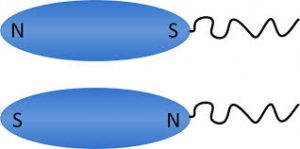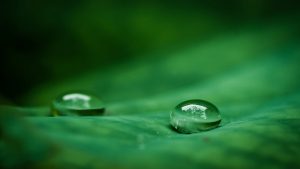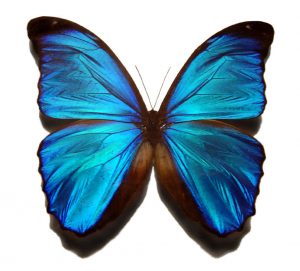Faced with the challenge of determining where we are and where we are going, humans took advantage of the magnetic field of the earth to provide a consistent orientation, with our invention of the compass, in 11th century China. Over 1.9 billion years prior, magnetotactic bacteria developed that same ability, albeit in a very different form. These bacteria contain chains of magnetic particles which orient themselves in response to the earth’s magnetic field, meaning the bacteria itself behaves like a compass needle, and will always point north (or south, depending on the species). This is one of many examples of how, in parallel to our development of technology through the use of the scientific method, the natural world has been using a different method, namely evolution, to develop its own tools which take advantage of physical phenomena.

Illustrative diagram of magnetotactic bacteria Credit: Wikimedia Commons
A study which highlights the continuing relevance of innovation in the natural world was conducted by a team of researchers at MIT. The team, headed by Kripa K. Varanasi, were looking into how to design surfaces which minimize the contact time of a bouncing drop. In situations where a liquid is dripping onto a hydrophobic (water-repelling) surface, the droplet of water will flatten upon hitting the surface, then reform a droplet and bounce off. The time it takes for the droplet to turn from its flat, pancake- like form into a droplet again is called the contact time. Minimizing contact time can be very important in applications such as the design of plane wings, where a shorter contact time can prevent drops of rain from freezing to the wing and beginning to build up.

Drops of water on a hydrophobic lotus leaf. Were these drops to have fallen onto the leaf, they would have first flattened, then reformed as droplets and bounced off. Credit: Flickr User Aotaro
Traditionally, contact time is reduced by decreasing the interaction between the liquid molecules and the molecules of the surface. When this interaction is decreased, it becomes more favourable for the water molecules to interact with each other, which causes them to clump together faster. However, once the liquid-surface interaction had been reduced to zero, no methods were known to further decrease the contact time. To get around this, the research group at MIT developed a new strategy, which has actually been used in nature for millions of years. By creating macroscopic ridges in the surface of the material, the researchers decreased the contact time by 40%. In their paper, the researchers acknowledge that both Morpho butterflies and the Nasturtium plant use macroscopic ridges in the same way: Morpho butterflies to keep their wings dry, and Nasturtium plants to clean their leaves. Lotus leaves are also very hydrophobic, and have often been thought to be the most hydrophobic surface in nature. However, because of these microscopic ridges, Nasturtium actually has a shorter contact time than even lotus leaves.

